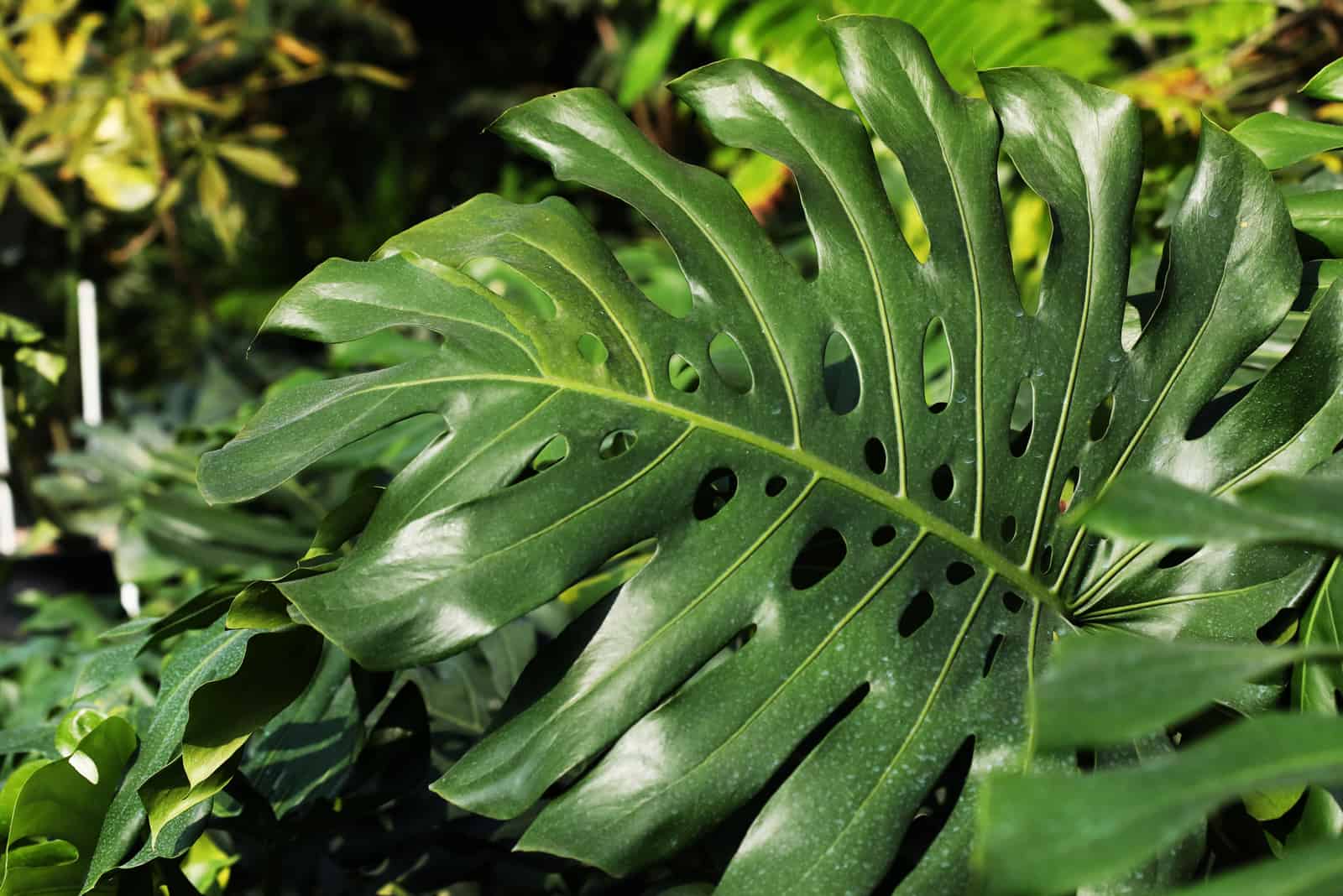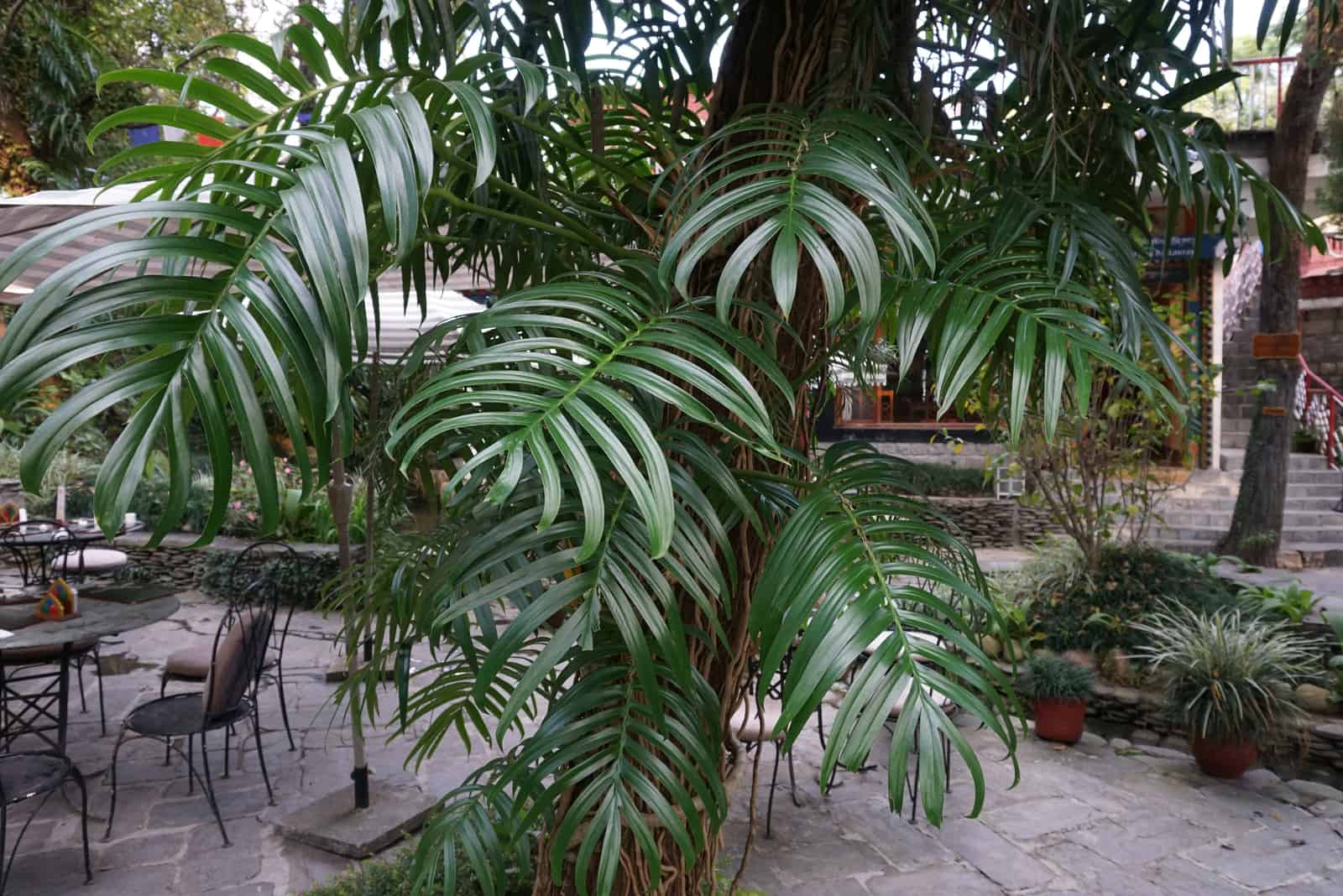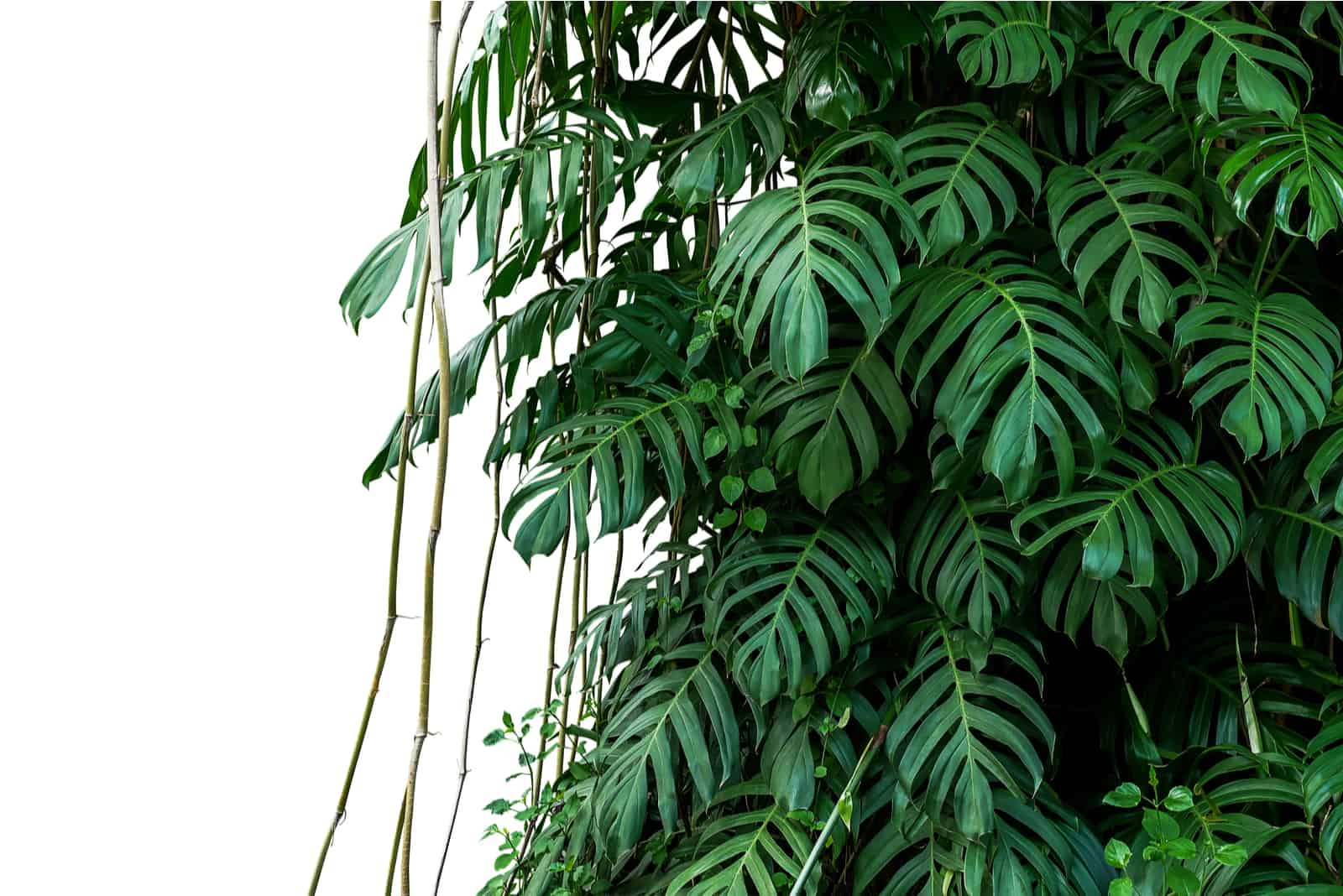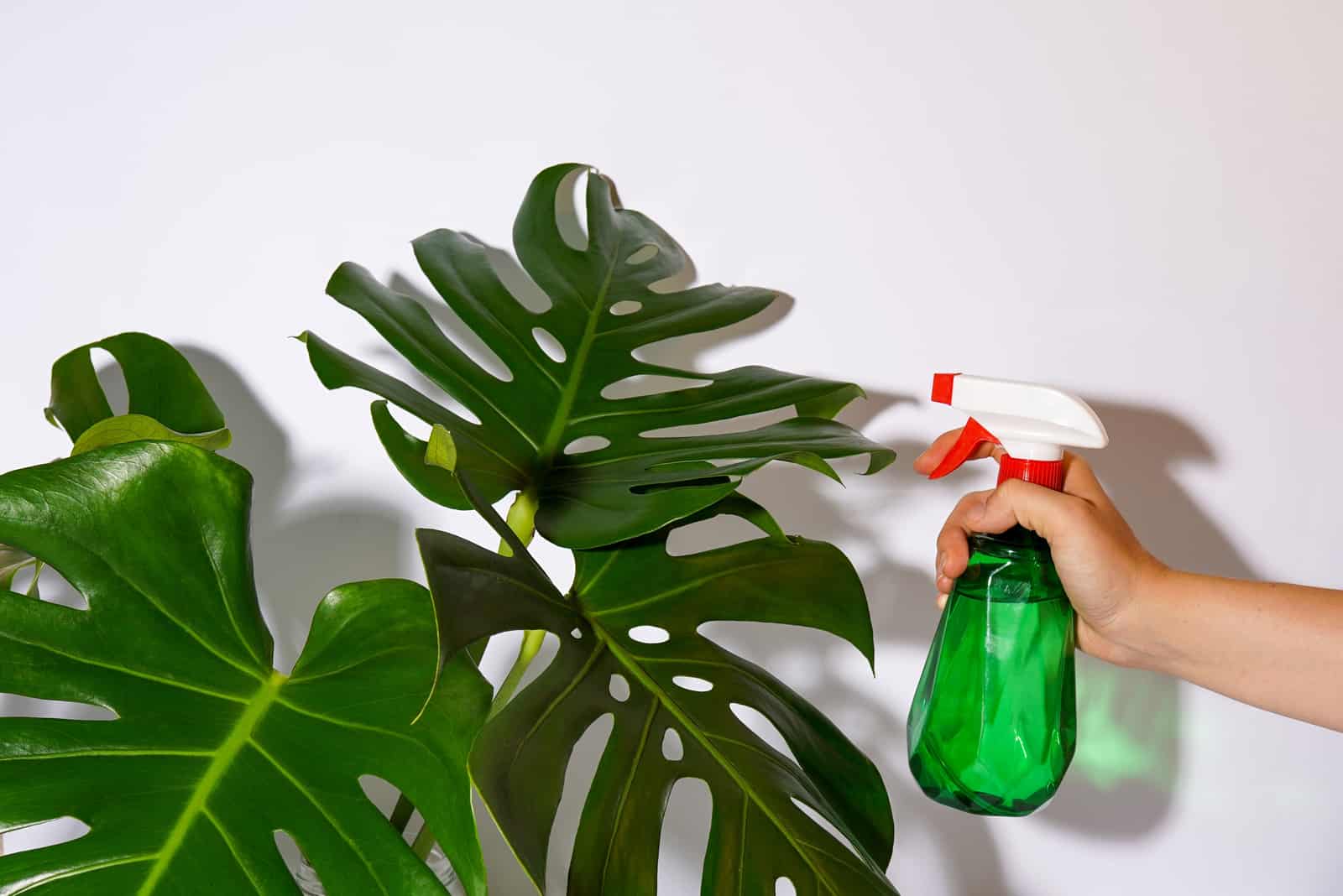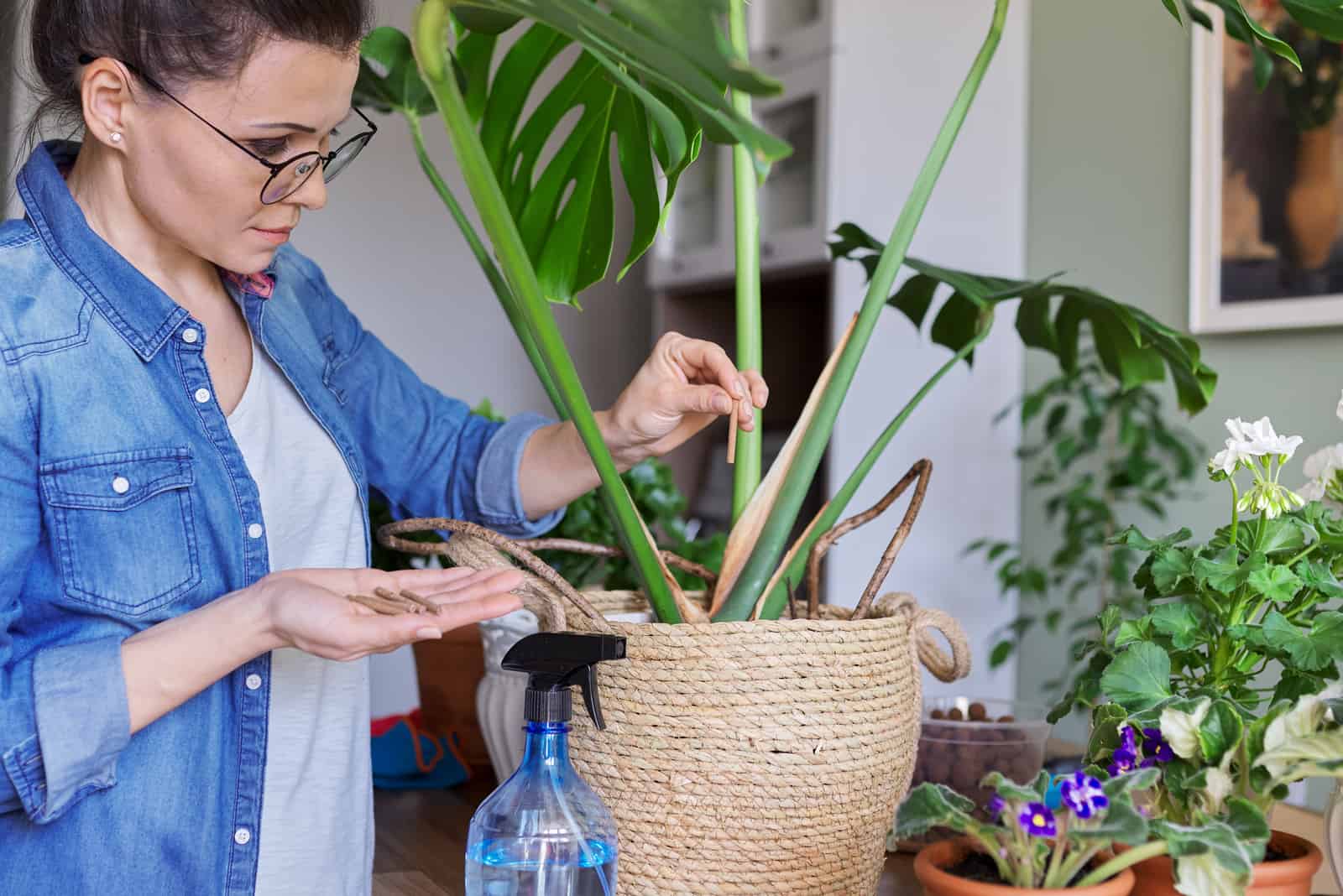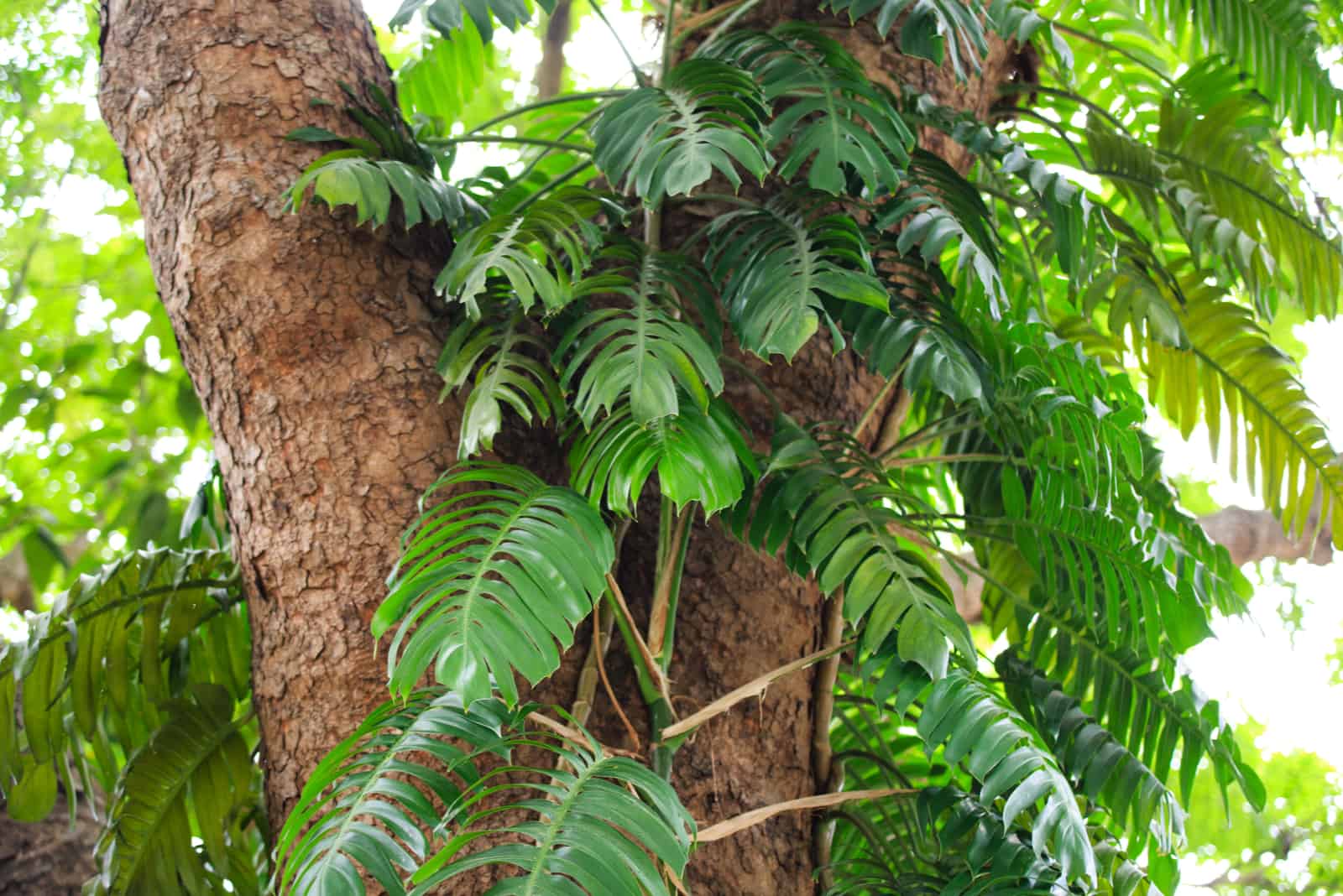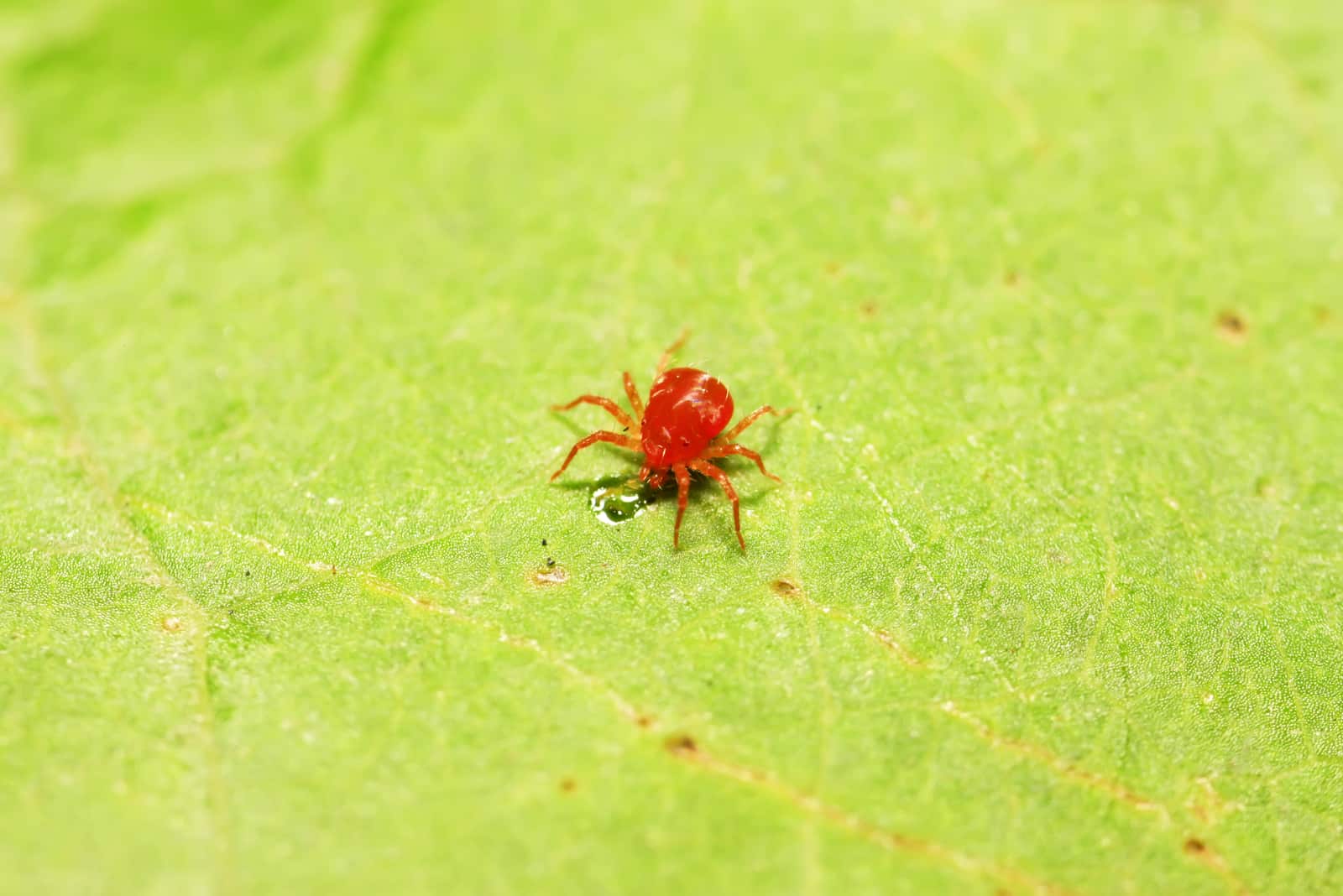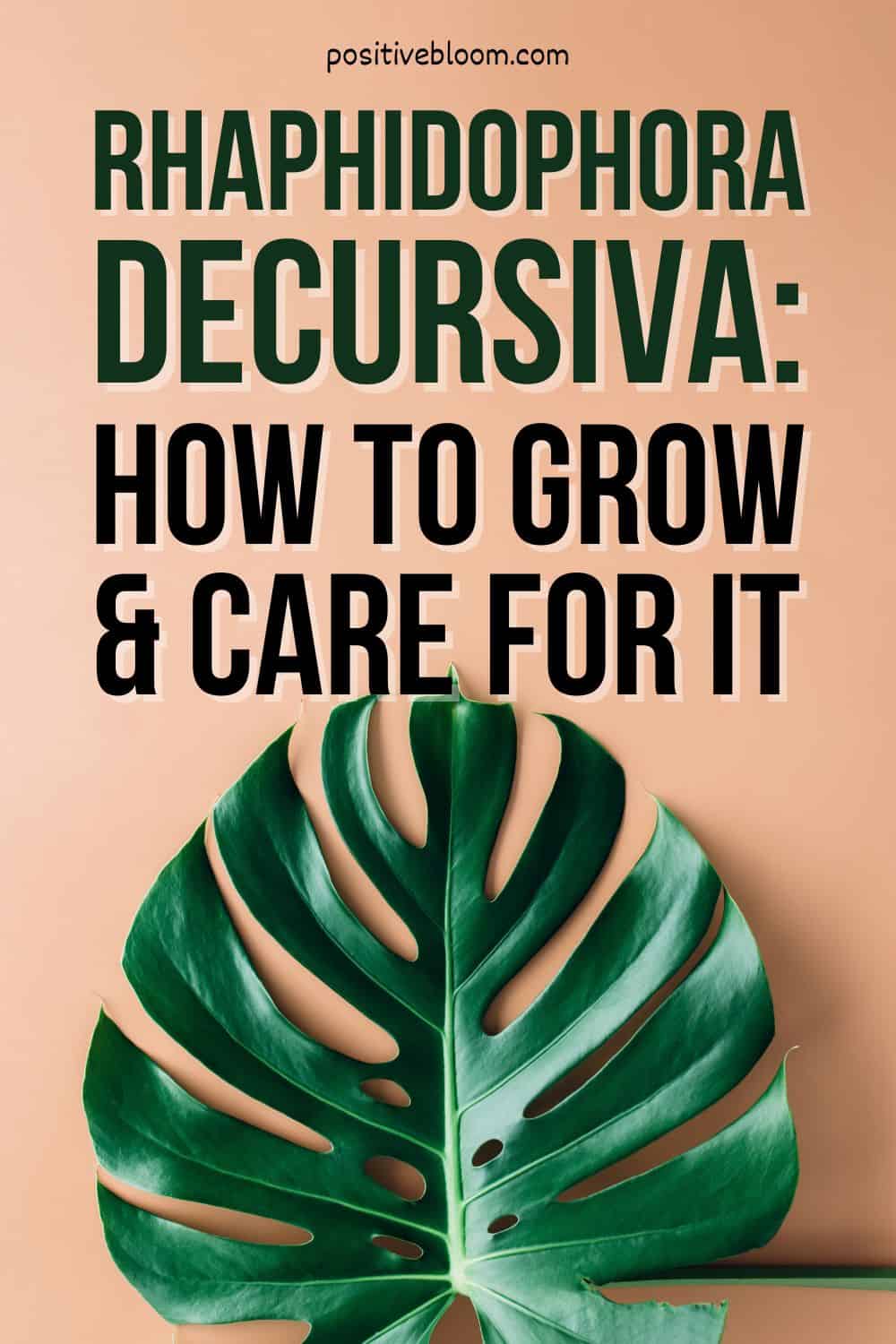If you ask experienced plant growers to recommend you a houseplant that’s both easy to care for and also breathtaking, most of them will say Rhaphidophora Decursiva!
So, what’s so special about this plant? Honestly, I don’t know where to start. First off, its fascinating leaves that differ in color when juvenile and mature are undoubtedly the main attraction.
The flowers and berries also make the plant stand out from other aroids.
The essential thing for decursiva when grown as a houseplant is that they’re provided with the right conditions. Otherwise, the plant won’t be half as beautiful as it could be.
You’ll need to adjust the light, humidity, and temperature, choose the right type of soil, fertilize, and repot the plant. Additionally, you’ll need to ensure the plant has enough space and something to climb on.
I was so fascinated when I discovered all these things above, that I decided to write this article!
Keep reading to find out everything you need to know about keeping your plant healthy and thriving.
Let’s begin with some basic info:
[table id=170 /]Let’s get into more detail!
What Does The Rhaphidophora Decursiva Look Like?
Before I tell you more about this plant’s appearance, I feel obliged to say that it’s often mistaken for many other plants. However, it seems like the decursiva has collected the most beautiful features of all the plants it resembles.
Let’s discuss the features of this plant, but also the differences between the Rhaphidophora and other plants from the same family.
Leaves
The juvenile leaves of the Rhaphidophora decursiva are small, oblong, and bluish-green.
However, as the plant ages it begins to produce enormous, split glossy green leaves. The leaves can grow up to 40 inches long and 20 inches wide.
In its native habitat, the decursiva produces leaves up to 3.3 feet long and 1.7 feet wide.
Decursiva leaves are pinnate, which means that they are divided into leaflets (pinnae) arranged on each side of the leafstalk.
Each leaf can have 9 to 15 pinnae per side. Decursiva leaves feature a green cylindrical petiole that measures 7.9 to 15.7 inches in length and has up to seven nodes that bear cataphyll. Petiolar sheaths cover around 2/3 of the size of these leaf stalks.
Stems
R.decursiva stems are thin when the plant is young, but as it matures the stems become thicker (1.1 to 2 inches).
Nodes produce aerial roots, but the axil produces branches. Decursiva plants have up to seven nodes between their leaves.
The aerial roots aid in the plant’s climbing or attachment to the host and nutrient absorption. They usually grow to be quite long and thick.
They will hug around tree trunks or other items for support in the wild. On the other hand, these aerial roots may die if they are not given a place to climb or attach.
Size, Growth Rate, And Habits
R.decursiva is a fast-growing climber, and this evergreen tropical liana can grow up to 66 feet in length.
When grown as a houseplant, the decursiva grows up to 8 feet long but needs climbing support.
We’ll discuss the best types of support later.
The Rhaphidophora plant grows under the forest canopy, but can also creep on the ground. This plant grows towards the light, which is essential to remember if you want to provide it with the right light conditions.
Fruit & Flowers
The berries of this Rhaphidophora plant are like a sticky pulp and come in various colors: orange, dark green, and yellow. The fruit isn’t edible.
When given the opportunity to mature, these plants typically blossom in the spring or summer. Nonetheless, they are unlikely to flower when grown as houseplants.
Their little yellowish-white flowers grow on an erect corn-like spadix and stick from a leaf-shaped spathe.
Epipremnum Pinnatum vs. Rhaphidophora Decursiva
The dragon tail plant, or Epipremnum pinnatum , is a climber and belongs to the Araceae family. This is one of the reasons the decursiva is often mistaken for the dragon tail plant.
Another reason is the leaf structure. Epipremnum pinnatum also has smaller juvenile leaves that divide to pinnae when they mature.
However, these two plants differ in many things. The first is the genus – Epipremnum and Rhaphidophora.
Decursiva has oblong leaves and Pinnatum has arrow-shaped leaves, depending on the variety.
Rhaphidophora Decursiva vs. Monstera
The plant most often confused with decursiva is Monstera. There are some reasons for this, but R.Decursiva isn’t a Monstera.
The confusion comes when the Rhaphidophora plant is confused for Monstera decursiva. The problem is there is no such species as the Monstera decursiva!
The plants from the Rhaphidophora genus are often confused with the plants from the Monstera genus. One such plant is the Mini Monstera, or Rhaphidophora tetrasperma , which belongs to the Rhaphidophora genus but resembles a Monstera Deliciosa.
Both the R.decursiva and Monstera are evergreen plants with similar leaves. The monstera’s leaves are also glossy and some species from this genus may have pinnate leaves.
Rhaphidophora Decursiva vs. Philodendron
Confusion may also arise if you hear the name “creeping Philodendron”. Most growers think that this Rhaphidophora plant is a Philodendron, but just like with Monstera plants, Philodendron plants belong to a different genus.
Many refer to this plant as Philodendron decursiva, but there is no such species.
The confusion between decursiva and Philodendron came about due to the similar shape of the juvenile leaves of both plants.
However, the decursiva isn’t a Philodendron or Monstera, but rather an entirely different plant. It’s also questionable if the variegated decursiva even exists, so be careful if someone offers to sell you one.
Rhaphidophora Decursiva Care Guide
As mentioned, the Rhaphidophora plant is low-maintenance, so ensuring the right conditions shouldn’t be a problem.
You’ll have to pay great attention to the requirements of this plant if you want to see it thrive, however. It’ll forgive you if you forget about it for a little while, but don’t expect the leaves to be as beautiful as possible if you do.
Partial shade, warm temperatures, high humidity levels, well-draining soil, moist soil, and occasional fertilizing are the requirements of this Rhaphidophora plant.
Let’s get into details!
Light
The essential thing to remember about this plant is its native habitat. Bear in mind that it grows under the forest canopy, which means that the decursiva isn’t exposed to direct sunlight.
Shade or a place with bright indirect light will work well for this plant. It may tolerate medium to low light, but will grow very slowly in these conditions.
These plants grow towards the light source.
You should never expose this plant to direct sun because it’ll burn the leaves, the tips and edges will turn brown and crispy, and the plant will look dull.
You can grow this Rhaphidophora plant outside, but you’ll need to find it a place with partial shade. Your plant will grow just fine in a greenhouse, and a 30-40% shade cloth will also benefit it.
Even though most tropical plants require a south or east-facing window, that’s not the case with this plant. Any window will do, just make sure to place the plant a few feet away from it.
Temperature
This Rhaphidophora plant enjoys warmer temperatures, ideally between 60 and 80 degrees Fahrenheit.
It’s not challenging to maintain these temperatures in most homes.
This Rhaphidophora plant can tolerate slightly lower (55 degrees Fahrenheit) or higher (85 degrees Fahrenheit) temperatures, but you’ll need to ensure proper hydration if the temperatures are on the higher side.
Unfortunately, these plants aren’t frost-tolerant. If you grow it outside and the temperature drops below 50 degrees Fahrenheit, take the plant inside as it could die.
Additionally, this plant despises cold drafts, so keep it away from air conditioners and vents. You should also keep these plants away from heating sources such as radiators and fireplaces as they can’t withstand temperature fluctuations.
Humidity
This plant is native to the tropical parts of Southeast Asia, the Indian subcontinent, and China, which means that this Rhaphidophora plant prefers high humidity levels.
You’ll need to ensure humidity is over 60%, so you likely need to consider increasing the humidity levels in your home. Luckily, there are a couple of methods you can use.
The first one is expensive but has a high success rate. A humidifier will increase humidity and also monitor the levels, so you won’t need to worry about humidity with one of these.
Most growers prefer DIY versions of humidifiers. For example, you can place a pebble tray underneath the pot to gain the desired effect, but make sure the roots aren’t touching the water.
If you grow other plants, the decursiva will benefit if placed next to them. It’ll not only look fantastic if you group the plants, but they’ll also spread humidity evenly.
So, if you grow a Scindapsus decursiva, place it next to your Rhaphidophora decursiva.
Another thing you can do is to move your decursiva to a bathroom or kitchen.
Misting is a quick and simple way of increasing humidity levels. Mist the leaves now and again, but don’t leave them wet for too long or they’ll become susceptible to fungal infections.
Soil
Every houseplant requires a specific potting soil, and the decursiva is no exception.
There are four requirements the soil must meet:
1. It has to be slightly acidic. A pH ranging from 5.6 to 6.5 will work best.
2. The soil for your decursiva should be well-draining, so you’ll have to ensure it contains materials that improve drainage.
3. Loamy soil is an excellent option for this plant, so using compost based on loam will do wonders.
4. The soil for this Rhaphidophora plant should be rich in organic matter.
You can use a soil mix made for Aroids, and add a little perlite to improve drainage and peat moss to help the soil retain water. Peat moss will lower the pH, but it’s rich in nutrients, which makes it perfect for your decursiva plant.
The great thing is that you can make your own potting mix. A great mix would be a combination of 50% all-purpose potting soil, 30% orchid bark, 10% perlite, and 10% peat moss.
Another great combination for potting mix contains 1/3 peat moss and coco coir, 1/3 perlite and vermiculite, and 1/3 sphagnum moss.
Vermiculite and orchid bark improve air circulation, so you should definitely consider adding them when making your own mix.
Watering
When it comes to watering decursiva plants, it’s all about balance. They won’t grow well in waterlogged soil (they probably won’t grow at all, in fact), but they also won’t take well if the soil is completely dry.
The best idea would be to let the top 2-3 inches of soil dry between waterings and then water the plant thoroughly until all the excess water comes out of the drainage holes.
Light, humidity, and temperature play leading roles in the watering schedule of this Rhaphidophora plant. If you adjust all the conditions according to the plant’s needs, you’ll need to water the plant approximately once a week. However, always check the soil moisture before you water your decursiva.
For example, if the plant receives more light than it should, the watering needs will increase. The same goes for low humidity and high temperatures.
Watering needs are different in the growing season; the plant needs watering more often. On the other hand, when the plant isn’t growing actively in the fall or winter, you’ll need to cut back on watering. Make sure the soil never gets completely dry, though.
When it comes to the watering method itself, I suggest bottom watering or immersing half of the pot in water. Ensure all excess water comes out of the drainage holes and remove any water from the saucer.
When grown outdoors, the decursiva needs saturated soil (6-8 inches deep), but only water it early in the morning or the late afternoon.
Drip irrigation systems and mulching can be beneficial for outdoor decursiva plants.
Be careful with watering as both overwatering and underwatering may cause damage to the plant.
Let’s look at what can happen more closely!
Overwatered R. Decursiva
Overwatering is a nightmare for tropical plants grown as houseplants, and many factors contribute to overwatering.
For example, if you grow your decursiva in a pot without drainage holes, excess water remains and the soil becomes waterlogged.
If the soil is too compact or made of such materials, the soil will soon become waterlogged.
Additionally, the pot size also matters. A pot that’s too large will retain too much water, and the roots are most likely to suffocate.
Here are the signs of an overwatered decursiva.
• Yellow leaves
• Wilting or drooping
• Moldy soil
• Mushy stems
• Defoliation (leaves dropping)
All these signs are most commonly initiated by root rot. You can see more about root rot and how to fix it in the section on common issues.
Underwatered R. Decursiva
Although underwatering isn’t as dangerous as overwatering, severe damage can still occur.
Here are the signs of an underwatered or dehydrated decursiva.
• Crispy leaves with brown edges and tips
• Leaves curling upwards
• Stunted growth
• Yellow leaves
Fertilizing
As far as the fertilizing schedule is concerned, the best idea would be to fertilize your decursiva once or twice a month.
The plant goes dormant during colder seasons (winter and fall), so it should be fertilized during the growing season (spring and summer).
Decursiva requires a balanced houseplant fertilizer, such as 20 20 20 or 10 10 10. Always dilute the fertilizer to half strength to avoid fertilizer burns.
Please follow the instructions written on the package of the fertilizer so you can avoid all these issues.
Pruning
Luckily, pruning isn’t a must for this Rhaphidophora plant. You only need to remove yellow, dead, or damaged leaves to keep the plant healthy and thriving.
Some growers prefer different shapes and want to control the size of their decursiva, so they cut a couple of long stems. Pruning for this reason will encourage the branches to grow in the desired way.
Before pruning, always sterilize the gardening tools you use (scissors, pruners, or shears) to avoid transmitting any diseases.
Repotting
Decursiva is a plant that hates being rootbound. As these plants are fast growers, they’ll need repotting more often.
Repot your decursiva every year or as soon as you notice it’s rootbound. You can check the drainage holes to see when the plant is rootbound. If the aerial roots are coming out of the pot’s drainage holes, it’s time to repot the plant!
The first thing you can do is take your decursiva out of the pot gently. If the plant doesn’t come out quickly, tug the pot a little bit.
When you take the plant out of the pot, you’ll notice the roots are growing in a circle. If you don’t repot the decursiva in this stage it will grow slowly, the leaves will start yellowing, and the plant may show signs of wilting.
Here’s a list of important things to pay attention to when repotting.
• Always use a fresh potting mix when repotting.
• Choose the right pot size. The new pot shouldn’t be too large as the excess soil may retain more water and suffocate the roots.
• Choose a deep pot. The decursiva grows strong and deep roots, so make sure the pot is deep.
• The best idea would be to repot the plant in spring at the beginning of the growing season.
Decursiva is a climbing plant, so it’s essential to ensure it has adequate support. A trellis, moss pole, or any of these alternatives to moss poles will work well.
Cleaning
You may think that cleaning your plants isn’t a part of plant care, but you should never skip this step!
Dip a sponge in water and rub the decursiva to maintain its healthy and large leaves. In this way, you’ll both remove dust and also mist the leaves a little bit. Let the leaves dry out entirely as excess water may cause them to rot.
R.Decursiva Plant: Propagation Methods
The decursiva can be propagated, but don’t worry, it’s not rocket science!
You can choose between two propagation methods: stem cuttings and air layering.
Let’s first see how to propagate using stem cuttings!
Stem Cuttings
Propagating by stem cuttings is straightforward, and you can propagate the stem cuttings in soil and water.
Before you start propagating, you’ll need to prepare a few things.
First, you need to prepare cutting tools. Depending on your preferences, you can use knives, scissors, pruners, or shears. The most important thing is that they should be sharp and sterilized.
You can use rooting hormone if you want to accelerate the process. However, it’s optional and propagation will have a high success rate without it. The same goes with a transparent plastic bag.
Always use fresh potting mix when propagating and prepare a small pot.
Here are the steps.
1. Fill a small pot with fresh potting mix and water the potting mix thoroughly.
2. Select a healthy decursiva stem with at least one leaf and one node with aerial roots attached. Cut the stem with a sterilized cutting tool.
3. If you decide to use root hormone, this is when you apply it.
4. The next thing is to make a hole in the potting mix and place the cutting into it. Gently press the soil around the decursiva cutting so that it stands upright.
5. Water the cutting and place it in bright indirect light. The ideal temperature for this matter ranges from 70 to 75 degrees Fahrenheit.
6. If you decide to use a plastic bag to maintain humidity, it’s time to place it over the cutting. Remove the bag a couple of times a week so the cutting can breathe.
7. Mist the mix once a week, but make sure it’s not soggy as your cutting may rot.
You can expect the new decursiva roots to sprout in about a month. Transplant the roots when they’re about 4-5 inches long.
Stem Cuttings In Water
You can place the cuttings in water before planting them in the soil. The advantage of this propagation method is that you can see the roots sprouting as the jar or glass used in this procedure is transparent.
Place your cutting in water, but make sure the leaves are above the water to prevent them from rotting. Place the jar or glass in bright indirect light.
Change the water regularly as the roots may rot and you won’t get a new plant.
When the roots are 4-5 inches long, it’s time to transplant the cutting.
Air Layering
When your decursiva grows aerial roots, you can use them for propagation. This method is called air layering.
Here are the steps.
• Take a horticultural moss and water it. Wrap it around the decursiva stem and secure it with a wire.
• You won’t need to wait for too long for the aerial roots to multiply and start peeking from the moss. When you notice some aerial roots, cut them below the stem.
• Plant the cuttings in fresh soil and mist regularly.
Common Issues
The issues that may occur with your decursiva plant are related to discoloration of the leaves, diseases, and pests.
Let’s dig a little deeper!
Yellow Leaves
There are many reasons decursiva leaves turn yellow. As well as overwatering and underwatering, the causes may also be aging (normal), cold temperatures, excess light, or lack of fertilization.
Adjust all the conditions, and if the leaves continue turning yellow it’s time to inspect the roots.
However, there is a disease called tobacco mosaic virus (TMV) which can also cause the leaves to turn yellow.
Unfortunately, the disease is lethal to most houseplants, so it would be best to isolate the plant if you suspect it has the virus. If you are sure that the plant is suffering from TMV, it would be best to discard it.
Root Rot
As mentioned, overwatered soil creates a suitable environment for bacteria to spread rapidly. The first thing to suffer are the roots.
The soil will have a mushy appearance followed by an unpleasant smell. The leaves may turn yellow and the plant may have a wilting appearance. The affected roots will be black or brown and mushy.
It would be best to remove the affected roots using sterilized scissors or pruners and repot the plant.
Pests
Unwanted guests who often visit decursiva plants are mealybugs, spider mites, and scale.
If you spot any webbing around the stems and on the leaves, spider mites are likely to be the pests in question.
A sticky, whitish substance is a tell-tale sign of mealybugs.
Honeydew on the leaves is a sure sign of scales.
The good thing is that you can easily get rid of these annoying creatures by rubbing neem oil or alcohol on the leaves.
FAQs
Is the Monstera decursiva toxic?
Yes, the Monstera decursiva is toxic. All parts of this plant are toxic to humans and pets. It contains needle-like insoluble calcium oxalate crystals that may cause mouth or throat swelling, diarrhea, or a burning sensation.
What are the benefits of a Rhaphidophora decursiva?
The R. decursiva is a low-maintenance plant suitable for beginners. This plant is also an air purifier, which makes it a great addition to your home.
Wrapping Up
There are many reasons you should get yourself a Rhaphidophora decursiva!
It’s undoubtedly one of the most beautiful houseplants, and as it’s easy to care for it won’t take much of your time.
Provide it with the right conditions, and you’ll see why it’s worth it!
Until next time!
Like this post? Share or pit it for later!

